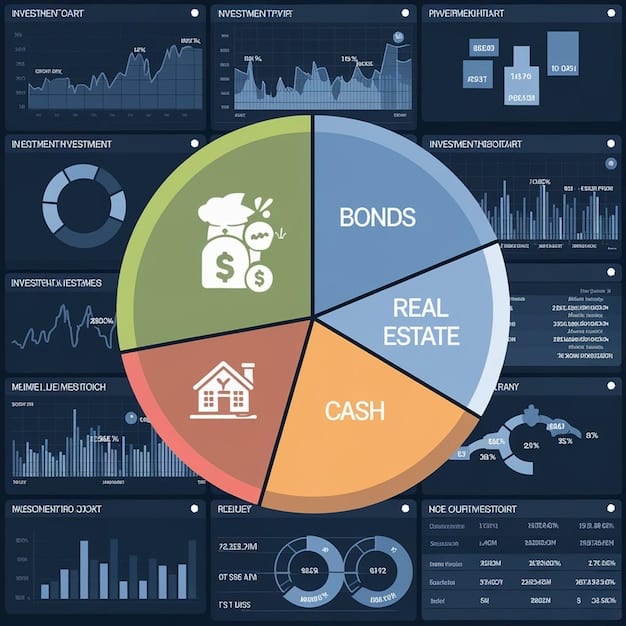Rebalance Your Portfolio for 2025: A Step-by-Step Guide

How to rebalance your portfolio for 2025 involves assessing your current asset allocation, setting target allocations, identifying over- and under-weighted assets, and adjusting your holdings through buying or selling to align with your investment goals and risk tolerance.
Are you ready to optimize your investments for the coming year? This guide will walk you through how to rebalance your portfolio for 2025: a step-by-step guide, ensuring your assets align with your financial goals and risk tolerance.
Why Rebalance Your Portfolio for 2025?
Rebalancing your portfolio is crucial for maintaining your desired asset allocation and risk profile. Market fluctuations can cause your portfolio to drift away from your target, making it essential to periodically realign your investments. Here’s why it’s important to address how to rebalance your portfolio for 2025.
Maintain Your Risk Tolerance
Over time, some assets in your portfolio will grow faster than others, potentially increasing your overall risk exposure. Rebalancing helps you stay within your comfort zone.
Stay Aligned With Your Financial Goals
Your financial goals may change over time. Rebalancing ensures your investments still support your objectives, whether it’s retirement, education, or a major purchase.

Rebalancing regularly is a proactive approach to investment management. Here are some key benefits:
- Disciplined Investing: It forces you to sell high and buy low, capitalizing on market opportunities.
- Risk Management: It prevents your portfolio from becoming overly concentrated in one asset class.
- Long-Term Growth: It ensures your investment strategy remains effective and adaptive.
In summary, rebalancing your portfolio is a necessary step in optimizing your long-term financial health, aligning your investments with your risk tolerance and financial aspirations.
Step 1: Assess Your Current Asset Allocation
The first step in rebalancing your portfolio is to understand your current asset allocation. This involves identifying all the assets you hold and determining the percentage of each asset class in your portfolio. Let’s break down how to rebalance your portfolio for 2025 by starting with an accurate assessment.
To begin, compile a list of all your investments, including stocks, bonds, mutual funds, ETFs, real estate, and any other holdings.
Calculate the Percentage of Each Asset Class
Determine the current market value of each investment and calculate what percentage of your total portfolio each asset class represents.
Tools for Assessment
Utilize online portfolio trackers, spreadsheets, or professional financial advisors to help you calculate your current asset allocation. These tools can provide valuable insights.

To accurately assess your asset allocation, consider these points:
- Use Consistent Metrics: Ensure you are using up-to-date market values for all assets.
- Include All Holdings: Don’t forget to include retirement accounts, taxable accounts, and any other investment vehicles.
- Categorize Properly: Accurately classify each investment into its respective asset class, such as large-cap stocks, small-cap stocks, or international bonds.
Assessing your current asset allocation is not just a mechanical task; it’s an important step in understanding how your previous investment decisions have shaped your portfolio and how well it currently aligns with your goals and risk tolerance.
Step 2: Define Your Target Asset Allocation
Defining your target asset allocation is a fundamental part of rebalancing your portfolio. This involves deciding what percentage of your portfolio should be allocated to each asset class based on your risk tolerance, financial goals, and time horizon. Here’s a detailed look at how to rebalance your portfolio for 2025 by setting clear targets.
Your target asset allocation should reflect your appetite for risk. Conservative investors may prefer a higher allocation to bonds, while more aggressive investors may favor stocks.
Your target asset allocation also depends on what you hope to achieve with your investments, whether it’s retirement, education, or another long-term goal.
Consider Your Time Horizon
The amount of time you have to reach your goals can influence your asset allocation. Longer time horizons may allow for more aggressive investing.
Consider these factors when defining your target asset allocation:
- Age and Life Stage: Younger investors typically have a longer time horizon and can tolerate more risk.
- Financial Situation: Your income, expenses, and other assets can influence your ability to take on risk.
- Investment Knowledge: Your understanding of different asset classes can impact your comfort level with various investments.
By carefully considering these factors, you can create a target asset allocation that aligns with your personal circumstances and helps you achieve your financial objectives.
Step 3: Identify Over- and Under-Weighted Assets
Once you know your current and target asset allocations, the next step is to identify which assets are over- or under-weighted in your portfolio. Understanding these imbalances is critical for how to rebalance your portfolio for 2025 effectively.
Compare your current asset allocation to your target asset allocation. Assets that make up a larger percentage of your portfolio than your target are over-weighted.
Similarly, assets that make up a smaller percentage of your portfolio than your target are under-weighted.
Use Spreadsheets and Tools
Use spreadsheets or financial software to visually compare your current and target allocations, making it easier to identify discrepancies.
When identifying over- and under-weighted assets, keep the following points in mind:
- Calculate Differences: Determine the exact percentage difference between your current and target allocations for each asset class.
- Set Tolerance Levels: Establish a threshold for when to rebalance. For example, you might only rebalance if an asset class is more than 5% over or under your target.
- Consider Tax Implications: Be aware of the tax consequences of selling assets in taxable accounts.
Identifying over- and under-weighted assets is essential for understanding where your portfolio has deviated from your intended strategy and for deciding how to bring it back into balance.
Step 4: Determine Your Rebalancing Strategy
Deciding on a rebalancing strategy is crucial for maintaining your desired asset allocation over time. This involves determining how often you will rebalance and the methods you will use to adjust your portfolio. Let’s consider the best strategies for how to rebalance your portfolio for 2025.
Rebalance your portfolio on a set schedule, such as quarterly, semi-annually, or annually. This approach provides consistency.
Rebalance your portfolio when your asset allocation deviates significantly from your target, regardless of the time interval.
Methods for Rebalancing
Buy or sell assets to bring your portfolio back into alignment with your target asset allocation.
Direct new investments into under-weighted asset classes to gradually rebalance your portfolio.
Here are additional factors to consider:
- Tax Efficiency: Minimize taxes by rebalancing within tax-advantaged accounts, such as 401(k)s or IRAs.
- Transaction Costs: Consider the costs associated with buying and selling assets, especially if you are rebalancing frequently.
- Automated Rebalancing: Some brokerage accounts offer automated rebalancing features, which can simplify the process.
Selecting the right rebalancing strategy is key to efficiently managing your portfolio and minimizing the impact of taxes and transaction costs.
Step 5: Execute Your Rebalancing Plan
Executing your rebalancing plan involves making the necessary trades to bring your portfolio back into alignment with your target asset allocation. This step requires careful attention to detail and an understanding of market conditions. Here’s advice on how to rebalance your portfolio for 2025 with precision.
Sell over-weighted assets and use the proceeds to buy under-weighted assets. This is the most straightforward method.
Direct new investments, such as monthly contributions, into under-weighted asset classes. This approach minimizes selling and can be tax-efficient.
Tax-Efficient Strategies
Rebalance within tax-advantaged accounts whenever possible.
Consider the tax implications of selling assets in taxable accounts. Minimize capital gains by selling assets held for longer periods and those with smaller gains.
When executing your rebalancing plan, keep these tips in mind:
- Monitor Market Conditions: Be aware of current market trends and potential impacts on your trades.
- Use Limit Orders: Protect yourself from unexpected price fluctuations by using limit orders to buy or sell assets.
- Review Your Progress: After making your trades, review your portfolio to ensure it is aligned with your target asset allocation.
Executing your rebalancing plan effectively ensures your portfolio remains aligned with your financial goals and risk tolerance, helping you achieve long-term investment success.
Step 6: Monitor and Adjust Regularly
Monitoring your portfolio and making regular adjustments is essential for maintaining your desired asset allocation over time. Market conditions change, and your financial goals may evolve, so it’s important to stay proactive. Here’s a guide on how to rebalance your portfolio for 2025 through ongoing management.
Track your portfolio’s performance regularly to identify any deviations from your target asset allocation.
Reassess your financial goals and risk tolerance periodically to ensure your investment strategy remains appropriate.
Adjustments for Life Changes
Major life events, such as marriage, children, or retirement, may require adjustments to your asset allocation.
Keep these insights in focus for ongoing portfolio management:
- Review Annually: At least once a year, conduct a thorough review of your portfolio and rebalancing strategy.
- Stay Informed: Stay updated on market trends and economic conditions that could impact your investments.
- Seek Professional Advice: Consider consulting a financial advisor for personalized guidance and support.
By monitoring your portfolio and making regular adjustments, you can ensure that your investments continue to support your financial goals and adapt to changing circumstances. This proactive approach is key to long-term investment success.
| Key Point | Brief Description |
|---|---|
| 📊 Assess Allocation | Evaluate current asset distribution. |
| 🎯 Define Target | Set desired asset percentages. |
| ⚖️ Identify Imbalances | Spot over/under-weighted assets. |
| 🔄 Rebalance | Adjust assets to meet targets. |
Frequently Asked Questions (FAQ)
▼
Rebalancing ensures your asset allocation aligns with your risk tolerance and financial goals, preventing overexposure to certain assets and maintaining a balanced investment strategy.
▼
The frequency depends on your strategy—either on a set schedule (e.g., annually) or when asset allocation deviates significantly from your target. Choose a method that suits your needs.
▼
Selling assets in taxable accounts may trigger capital gains taxes. Rebalancing in tax-advantaged accounts first can help minimize these tax implications and ensure efficiency.
▼
Consider your risk tolerance, financial goals, and time horizon. Your age, life stage, and investment knowledge are important factors in setting a suitable asset mix.
▼
Yes, many brokerage accounts offer automated rebalancing features that can simplify the process. These tools automatically adjust your portfolio to match your target asset allocation.
Conclusion
In conclusion, knowing how to rebalance your portfolio for 2025: a step-by-step guide involves careful assessment, strategic planning, and consistent execution. By following these steps, you can ensure your investments remain aligned with your financial goals and risk tolerance, setting you up for long-term success.





